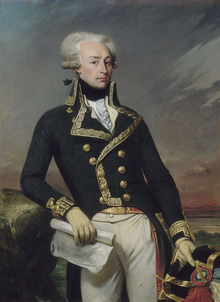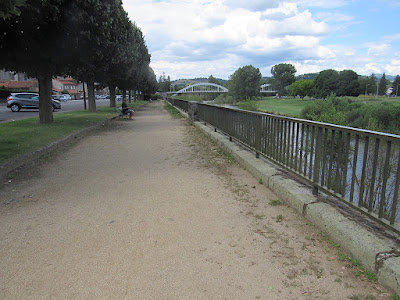
Gilbert du Motier de La Fayette was born in the chateau in Chavaniac (18.6 miles from Le Puy) in this bed on September 6, 1757. He had a happy childhood and showed gallantry and leadership befitting his family heritage even at a young age. For example, in the Auvergne area, the Beast of Gevaudan (a wolf) was terrorizing the people. Gilbert, age 10, took a small sword and vowed to kill the beast. "Be careful!" he said. "I am the lord of this village and it is my duty to defend it."
(George Washington's portrait on the right.)
In fact, Lafayette (American spelling) was from one of the oldest and most distinguished aristocratic families in France. Gilbert de La Fayette III was a companion-at-arms with Joan of Arc's army during the Siege of Orléans in 1429. According to legend, another elder helped capture the Crown of Thorns during the Sixth Crusade to Jerusalem. On his mother's side, several of his family members also had distinguished careers in the military.
Lafayette was raised in the chateau by his grandmother after his father had died while fighting a British-led coalition at the Battle of Minden in Westphalia. His grief-struck mother went to Paris to live with her father and grandfather. In 1768 when Lafayette was 11, he went to Paris to attend the Collège du Plessis, which was a part of the University of Paris. He enrolled in military training as a Muskateer.
Lafayette commanded troops in several battles and was wounded during the Battle of Brandywine in 1777. In the middle of the war he returned to France to solicit French support for what he considered "a noble cause". Upon his return to America in 1780, he served as a senior officer in the Continental Army. Most notable was his command of forces in Virginia that blocked the British and led to the Siege of Yorktown in 1781, which would decisively end the war.
 |
| Lt General in 1791; portrait by Joseph-Désiré Court |
After the war Lafayette returned to France. He was appointed to the Assembly of Notables in 1787, and in 1789 he was elected to the Estates General. In that same year he helped form the National Constituent Assembly (the forerunner to the National Assembly) and helped write the Declaration of the Rights of Man and of the Citizen with the assistance of Thomas Jefferson. The Declaration was inspired by the U.S. Declaration of Independence and it invoked natural law to establish basic principles of the democratic nation-state. After the storming of the Bastille on July 14, 1789, Lafayette was appointed commander-in-chief of the French National Guard. As an aristocrat and a supporter of the monarchy, he tried to steer a middle course during the Revolution. However, in August 1792, he was arrested by the revolutionaries. He fled into the Austrian Netherlands but was captured by Austrian troops. He spent five years in prison.
Lafayette returned to France in 1797 after Napoleon Bonaparte secured his release. He was offered a position in this government but refused it. In 1814, he became a liberal member of the Chamber of Deputies, a position he held for most of the rest of his life. In 1824, President James Monroe invited him to the United States as the nation's guest, and he visited all 24 states. During France's July Revolution of 1830, he was offered the opportunity to become France's dictator, but he refused. Instead, he supported Louis-Philippe as king, but turned against him when the monarch became autocratic. Lafayette died on May 20, 1834 and is buried in Picpus Cemetery in Paris, under soil from Bunker Hill (Charlestown, MA).
 Although frequently absent from his home in Chavaniac, he maintained connections to it throughout his life. He was particularly interested in the town's small farmers and artisans. He also showed his own creativity by suggesting that ships use hemp from the Auvergne region for their ropes and that vaccination could help prevent smallpox.
Although frequently absent from his home in Chavaniac, he maintained connections to it throughout his life. He was particularly interested in the town's small farmers and artisans. He also showed his own creativity by suggesting that ships use hemp from the Auvergne region for their ropes and that vaccination could help prevent smallpox. Below are several of the rooms of the chateau that help to illustrate the nature of the man and his times.
 The Philosophers' Salon exemplifies the 18th century's golden age of conversation and discussion of pertinent philosophical and literary issues and Lafayette was an avid participant. His main concern was the abolition of slavery. He was a man of strong opinions and his early successes had a negative effect on some people:
The Philosophers' Salon exemplifies the 18th century's golden age of conversation and discussion of pertinent philosophical and literary issues and Lafayette was an avid participant. His main concern was the abolition of slavery. He was a man of strong opinions and his early successes had a negative effect on some people: "My popularity is great in this kingdom and in this city, but there are many who are against me, jealous of my reputation." 1784

Wallpaper panels are in the arabesque style (surface decorations based on rhythmic linear patterns of scrolling and interlacing foliage, tendrils" or plain lines). Wallpaper was introduced in France in the 1770s. They imitated the painter, Raphael, who focused on antiquity motifs. The fashion of the day also included flowers, birds, insects, people and mythical animals.

The "Versailles" parquet floor of the 18th Century was made of oak, ash, sycamore, and walnut.
 The Treasure Room (a.k.a. "Chinese Room") served as Lafayette's office. It contains various objects that once belonged to Lafayette. It is also displays several murals in silver leaf that use a Chinese-inspired style unique to the era of Louis XV.
The Treasure Room (a.k.a. "Chinese Room") served as Lafayette's office. It contains various objects that once belonged to Lafayette. It is also displays several murals in silver leaf that use a Chinese-inspired style unique to the era of Louis XV.Dining Room

Interesting Doors and Hallways
Interesting Objects




 |
| Masons poster |
Lafayette belonged to the Masons, thanks to Fr. Reynal, a scholarly, anti-establishment man whom he admired. Reynal belonged to the "Nine Sisters" Lodge in Paris, which influenced literary circles there. Lafayette attended its meetings. His membership facilitated his relationship with George Washington, who was a grand master. Freemasonry or Masonry consists of fraternal organisations that trace their origins to the local fraternities of stonemasons that from the end of the 14th century regulated the qualifications of stonemasons and their interaction with authorities and clients.
The Gardens

The gardens behind the chateau were extensive, but unremarkable. Still, there were many interesting trees and ponds that lent to a tranquil and peaceful environment. A rose garden near the chateau was designed in triangles around a boy on a pedestal, which made for some interesting photographic angles.





 Lafayette married Adrienne de Noailles at age 16. It was an arranged marriage, but even from the first days, Adrienne, 14, held a lively and tender sentiment for her husband who was also her hero. Often left alone, she managed the couple's property and businesses on both sides of the family. Adrienne also watched over the political and private interests of Lafayette while facing with courage and determination the very difficult hours of the French Revolution. She and her two daughters were imprisoned during the Revolution, but they all eventually joined Lafayette in his prison in Austria. She was weakened and sick as a result of her captivity and died at age 48 in 1807. She was buried in the Picpus cemetery in Paris in her family's communal grave. Lafayette died on May 20, 1834 at age 77 and was buried with his wife.
Lafayette married Adrienne de Noailles at age 16. It was an arranged marriage, but even from the first days, Adrienne, 14, held a lively and tender sentiment for her husband who was also her hero. Often left alone, she managed the couple's property and businesses on both sides of the family. Adrienne also watched over the political and private interests of Lafayette while facing with courage and determination the very difficult hours of the French Revolution. She and her two daughters were imprisoned during the Revolution, but they all eventually joined Lafayette in his prison in Austria. She was weakened and sick as a result of her captivity and died at age 48 in 1807. She was buried in the Picpus cemetery in Paris in her family's communal grave. Lafayette died on May 20, 1834 at age 77 and was buried with his wife. The European oak dominates Chaliergue's forest landscapes and the
surrounding areas of Chavaniac. Its wood, rich in tannins, is used in
the manufacturing of barrels; it gives wine a subtle flavor of toasted
almonds and caramel.
The European oak dominates Chaliergue's forest landscapes and the
surrounding areas of Chavaniac. Its wood, rich in tannins, is used in
the manufacturing of barrels; it gives wine a subtle flavor of toasted
almonds and caramel.
The bald cypress produces pneumatophores at its base. These protrusions allow the tree to supply oxygen to its roots and improve its stability.






































